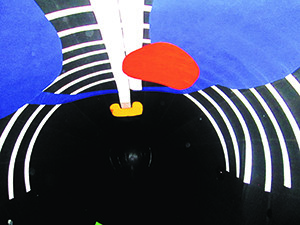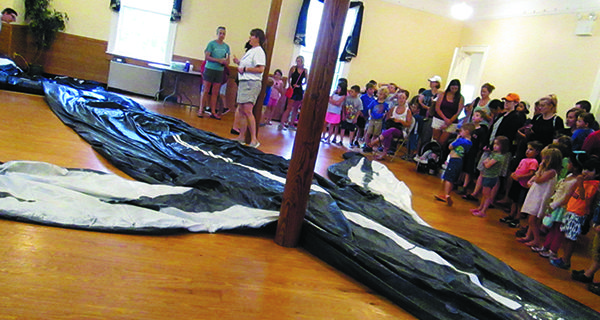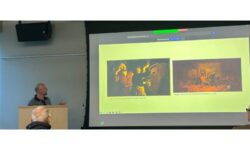[ccfic caption-text format="plaintext"]
By Cameron Small
Hometown Weekly Intern
Call me Ishmael, and prepare for Captain Ahab’s call of “Thar’ she blows!” Last Thursday, July 14, the Sherborn Library hosted Cynde McInnis, the creator of the Whalemobile and the inflatable humpback whale, Nile. Since Nile is a life-size inflatable, the event was held across the street at the Sherborn Community Center.
 McInnis, originally from Indiana, always had a fascination with whales. She remembers in grade school being told her art projects could not have whales in them after a certain point because she always incorporated them. In a desire to share her passion for whales, McInnis created the Whalemobile. She drives around the country with Nile and gives a presentation on whales—how to identify different whales, the differences between them, and the sounds they make. The presentation ends with the inflation of Nile, allowing kids to sit or walk around inside and learn about a whale’s anatomy.
McInnis, originally from Indiana, always had a fascination with whales. She remembers in grade school being told her art projects could not have whales in them after a certain point because she always incorporated them. In a desire to share her passion for whales, McInnis created the Whalemobile. She drives around the country with Nile and gives a presentation on whales—how to identify different whales, the differences between them, and the sounds they make. The presentation ends with the inflation of Nile, allowing kids to sit or walk around inside and learn about a whale’s anatomy.
Going inside Nile is the highlight of the presentation. Marlo Teja, 5, said she liked “learning about how it has three stomachs.” She also enjoyed seeing “her [Nile’s] heart. It weighs, like, ten of me.” Marlo’s twin brother Graham agrees, saying the heart “was really big.”
McInnis has a lot of analogies to explain different whale aspects to children. She uses pictures of herself and a student lying under a whale skeleton to give the kids an idea of the size of the jaw of a whale. To explain baleen, she uses breakfast cereal as an example, with the caveat “Don’t eat like this tomorrow. But put the cereal in your mouth. Now spit the milk out through your teeth. What’s left in your mouth? The cereal, right. Swallow it. That’s how whales eat.”
Baleen whales can eat a whole lot at once, and that’s why they tend to live alone. In contrast, toothed whales can only eat one fish or squid at a time, and so they tend to live in groups, never more than a few miles apart from each other.
Next, McInnis went into how humpback whales can be identified. Each humpback has a unique marking on its tail that is as unique to the whale as fingerprints are to people. The markings on its tail are how scientists and researchers know which whale is which. Nile is named as such because the markings on her tail look like the Nile River delta. Another whale McInnis showed had whisker-like markings similar to a walrus, and so that whale’s name was Walrus. A third had an X on their tail, and was consequently named Treasure.
The markings on the tail also help tell the genealogy of the whales. Scientists can tell which whales have mated and who their offspring are, building family trees for the whales.
After the few minutes of learning about tail markings, the part most (if not all) the kids were waiting for arrived—the inflating of Nile. Once the folding chairs were stacked away, out came Nile. Deflated, she covered three quarters of the floor on the diagonal. Once inflated, she covered roughly 75 percent of the room. Kids screamed, some in delight, others in fear as Nile grew from deflated flatness to life-sized whale in front of their very eyes.
Originally, McInnis wanted the Oscar-Meyer Wienermobile for her presentation, and just add flippers and a tail to it. She realized that was not completely realistic, and that “a really great inflatable would be a close second to that.”
When not touring the country with Nile, McInnis works for Cape Ann Whale Watch, a company based out of Gloucester. McInnis proudly says it’s her twenty-third season with Cape Ann. She’s disappointed she has yet to see Nile this year. McInnis recalls her first trip with Cape Ann, “The very first trip I did as a naturalist, she [Nile] played with the boat. I just have a very, very vivid memory of her right next to the boat bringing her head out of the water.” Besides the markings on her tail, Nile has a very distinctive hook in her dorsal fin, which allows people to recognize her without seeing her tail.
Nile and McInnis came to the Sherborn library two years ago, so if you missed this year’s trip, you might be able to see it again in a few years. Or better yet, go and see the real life Nile.






















